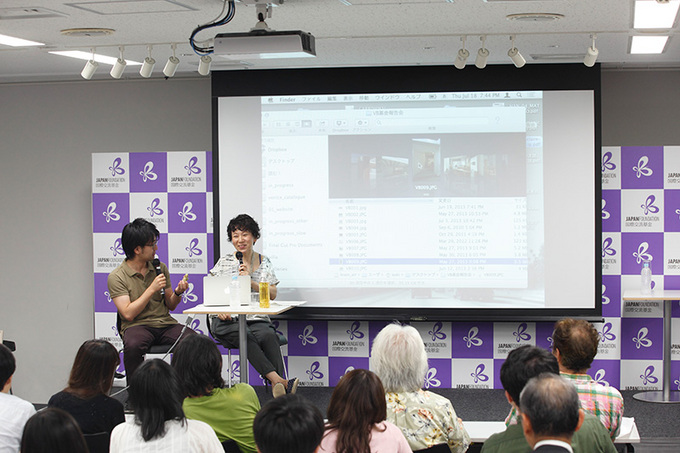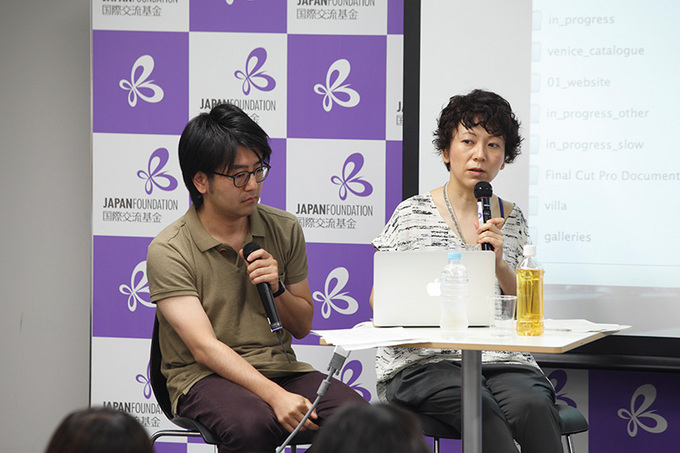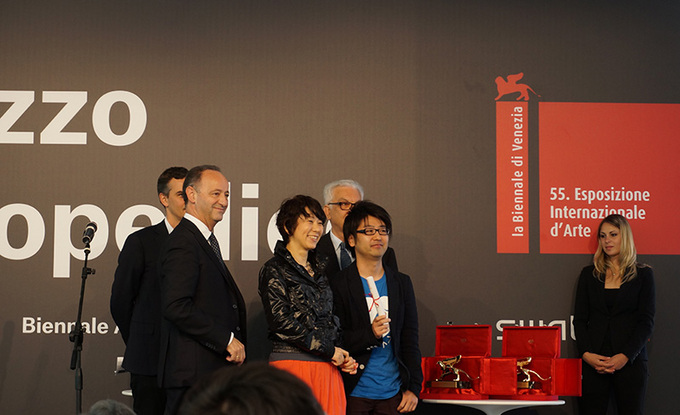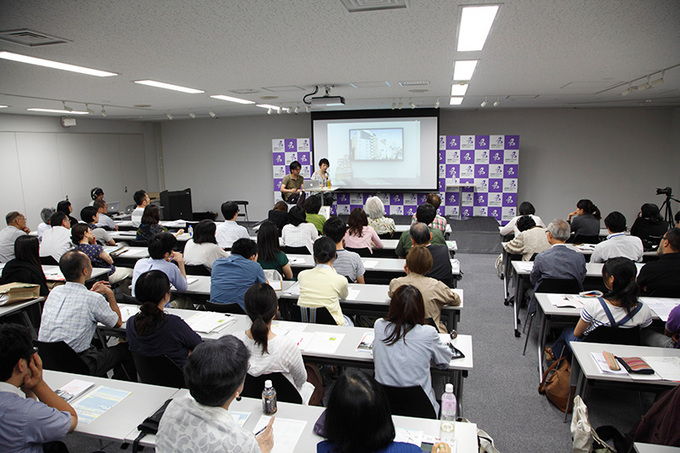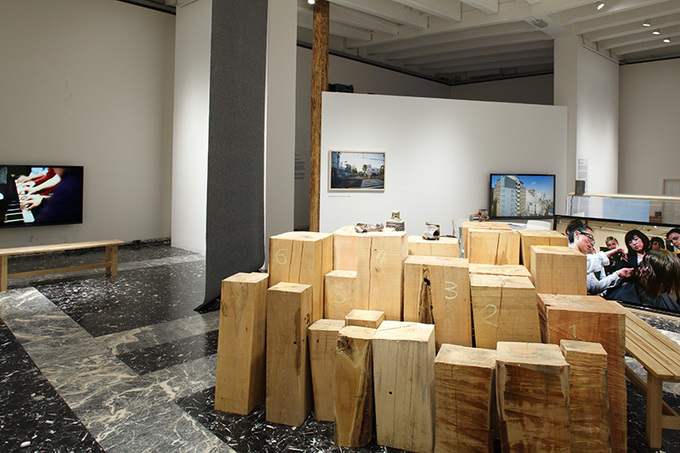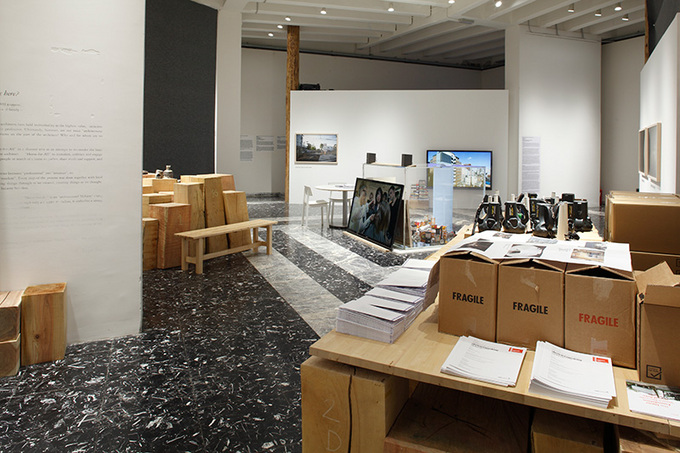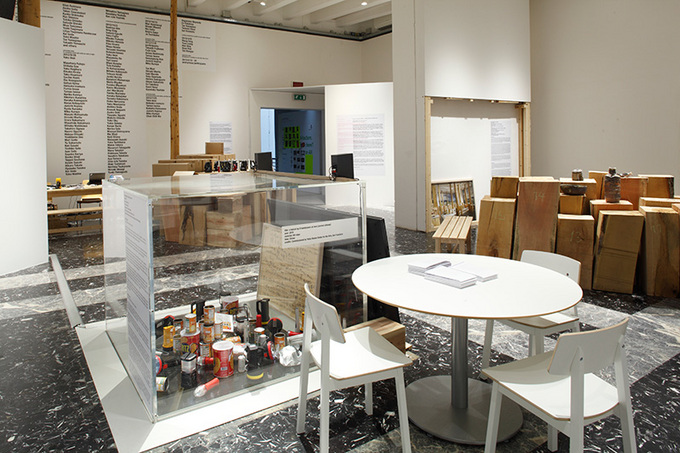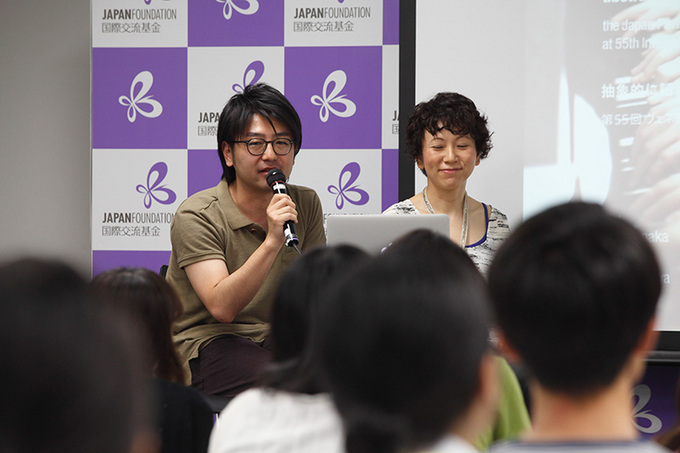Abstraction and the Possibilities of Collaboration--Report on the 55th International Art Exhibition of the Venice Biennale
Koki Tanaka
Mika Kuraya
The day June 1, 2013, saw the opening of the 55th International Art Exhibition of the Venice Biennale, and the Japan Pavilion exhibit entitled "abstract speaking--sharing uncertainty and collective acts," commissioned by the Japan Foundation, was awarded to a Special Mention.
After returning, exhibiting artist Koki Tanaka and curator Mika Kuraya reported on their experiences in Venice, and presented Hikaru Fujii's documentary video of the Japan Pavilion.
(The following was recorded at the Japan Foundation JFIC Hall "Sakura" on July 18, 2013.)
The message conveyed through abstraction
TANAKA: Ms. Kuraya and I were saying we have virtually nothing to add to Hikaru Fujii's documentary video.
KURAYA: Mr. Fujii's video is brilliant. It captures Venice exactly as we experienced.
That is, many people see the Venice Biennale as the greatest celebration of capitalism, a festival that attracts celebrity artists from around the world. But setting up an exhibit there actually involves a good deal of simple, modest work.
The video features countless inserts of the cleaning staff and security guards. Even the grandest of festivals is supported by down-to-earth labor, and only after the curtain rises does it transform into a spectacular party. The video shows both these sides, casting a critical eye on the relationship between art and ordinary labor. Not only is it an accurate representation of the Venice Biennale as a whole, it's also closely linked with the theme of the Japan Pavilion: collaboration.
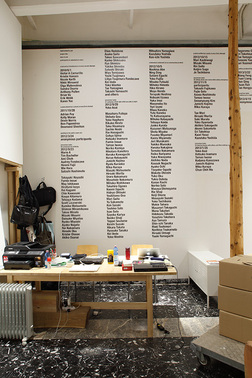 TANAKA: I posted a list of all the members who took part in this exhibition on the wall at the far end of the Japan Pavilion. To my surprise, I heard that the Japan Pavilion had never displayed the names of all its staff members before. My list might seem particularly long, since it contains an unspecified number of people involved in a plethora of collaboration projects. But then, every exhibition involves a large number of people. I've always thought it odd that the final exhibit usually doesn't give credit to the people who helped to create it.
TANAKA: I posted a list of all the members who took part in this exhibition on the wall at the far end of the Japan Pavilion. To my surprise, I heard that the Japan Pavilion had never displayed the names of all its staff members before. My list might seem particularly long, since it contains an unspecified number of people involved in a plethora of collaboration projects. But then, every exhibition involves a large number of people. I've always thought it odd that the final exhibit usually doesn't give credit to the people who helped to create it.
Up to now, I've had several opportunities to talk about the exhibition and the individual projects. So this time, I'd like to discuss about the people involved in the projects and the concept of abstraction, a term I chose for the title "abstract speaking."
KURAYA: The special mention to the Japan Pavilion brought a bigger buzz than either of us had imagined. In contrast to the Golden Lion and Silver Lion, special mentions are informal, supplementary awards presented to noteworthy exhibits. It seems that all the special mentions at this Biennale--the Japan Pavilion as well as the others--were selected not only for the quality of the exhibit but also for the representation of "collaborative nature." In our case, for instance, it is clearly stated that the jury took into account the "reflection on issues of collaboration and failure." It made me happiest of all that the jury recognized collaboration as an important theme, and what's more, other national pavilions and exhibiting artists shared that sentiment.
The Japan Pavilion managed to communicate this sentiment widely to the visitors thanks to the element of abstraction highlighted in the exhibition title. In 2012, when Mr. Tanaka and I were preparing for the competition to represent Japan, we agreed that we should deal with the Great East Japan Earthquake of March 11, 2011. The problem was, neither of us had a clue as to specifically how to do that. We asked another artist, Ken Sasaki, to take us on a tour of the disaster-hit areas, hoping to find some sort of hint. But given that Mr. Tanaka's signature approach toward art is through everyday objects and situations, I came to feel that it would go against the consistency of Mr. Tanaka's artistic style, if he were to start contributing directly to the disaster-hit areas, out of the blue, just for the Biennale.
And so we discussed how we could approach the devastating earthquake, tsunami, and nuclear disaster of 3/11 through the ordinary, and that was when Mr. Tanaka's concept of abstraction started to gain a sense of reality. Take, for instance, a behavioral statement (or an unconscious protest). The video simply shows staff members of the Japan Foundation going up and down a flight of stairs. That's it. But somehow it leads the viewer to interpret their walking as getting from place to place without using electricity, or a protest against nuclear power. This is precisely what's happening in post-3/11 society. We tend to see one action and interpret it as having some other, hidden meaning. And I thought this would be a feasible way for Mr. Tanaka's artistic style, examining the ordinary to approach the extraordinary--in this case, 3/11.
It's an ambiguous, roundabout way to deliver a message, yes. But in Venice, I felt that this ambiguity helped to open up each project to a broader spectrum of interpretations. Leaving the message unclear and hazy created a gap, and this allowed many viewers to identify with the projects through their own experiences.

a, staircase
a behavioral statement (or an unconscious protest)
TANAKA: I was the one who suggested the term "abstraction." But to be honest, I still don't fully understand it myself. Every time I was asked to explain it in Venice, I said the show represents the abstract as a contrast to the figurative. That is, the Japan Pavilion at the Venice Biennale International Architecture Exhibition in 2012 introduced a real activity in a disaster-stricken area, whereas we're presenting an abstract version. Then one day, someone questioned that explanation. He said even the abstract must contain some reality. In fact, every project I did this time consisted of real and specific action, which has to be based on the ordinary. Just because the direction it presents is ambiguous, can it be called abstract?
In the series I call precarious tasks, I organized one project in the Netherlands. It involved about 15 people going up to a hotel room. The sixth floor of the hotel was right about the height of 16.7 m--based on trace marks, the officially recorded maximum height of the 3/11 tsunami. I gave the group no specific information about the tsunami, but simply talked about water levels. I said the floor of that room was 16.7 m above ground, but didn't mention what it meant. After I'd finished talking, I let the participants leave freely. But many of them lingered on, murmuring quietly, for about half an hour. It seemed that they wanted to get a feel of what they were doing there. But I also believe they stayed because they were trying to accept the sense of insecurity presented by that precarious situation. Maybe the term I'd been looking for all along was not "abstract" but "precarious," which I did use in the title precarious tasks. All the projects require the participants to accept a precarious situation, and that process might be part real, part abstract. Lately that's how I've begun to digest my work in my own mind, anyway.
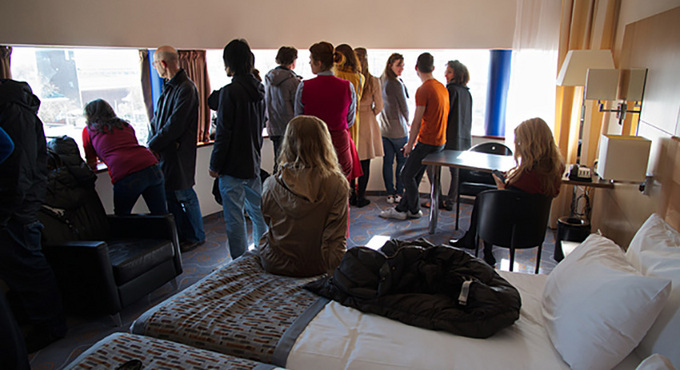
b-7, precarious tasks
#6 going up to a city building taller than 16.7m
KURAYA: I wrote an English-language text for the official exhibition catalog, and in it, I didn't use the term "abstraction" at all. I opted for terms like "metaphor" and "allegory" instead. Sometimes it's difficult to draw the line between the abstract and the figurative. Do we define tiny everyday action as real because they involve detail, or do we define them as abstract because they don't yet fit into a conceptual framework and their purpose is unclear and ambiguous? Different people might have different interpretations. So I felt that "metaphor" was a somewhat neater, tidier term for describing the projects.
For instance, why the piano? Why five collaborators? Why Chinese potters? No one can explain the tiny details that make up the situation in Mr. Tanaka's projects. When people experience a situation and they can't put their finger on what it means, they develop a subtle sense of insecurity. Then they switch their thought process and strive to find a new meaning for the experience. Mr. Tanaka's work stimulates this thought process--that's what I wrote in the text.
As I was writing it, I was thinking of Kunio Yanagita's Tono monogatari (The Legends of Tono). One of the tales is about the Meiji Sanriku Earthquake of more than a hundred years ago. It isn't a straightforward story about losing family, though. On the beach one moonlit night, a widower sees the spirit of his wife living happily in the afterworld with her first love. The sight gives him a shock, and eventually he dies, too. The question is, why bring in the supernatural and even romance, and turn a simple account of the earthquake into a fantasy? It certainly isn't necessary. But these elements whose meaning or purpose we can't readily identify have in fact helped a single experience to live on for over a century and continue to send us a message. I feel that Mr. Tanaka's work will have a similar effect.
An alternative direction for the Venice Biennale
TANAKA: Another thing I haven't spoken about much before is failure. What exactly did the special mention say?
KURAYA: To be accurate, the jury decided to give the "special mention to JAPAN for the poignant reflection on issues of collaboration and failure."
TANAKA: I wonder what "failure" refers to here. Does it mean that the attempts at collaboration were a failure, or that the Japan Pavilion admits they're a failure and presents them as such? The wording is so brief, it's hard to tell what it exactly means.
When we were chosen in the competition to represent Japan, it became a hot topic on Twitter whether our exhibit ideas had what it would take to win. It turns out we did succeed in winning, but owing partly to "failure." This must have completely disillusioned those who see the Biennale merely as a race. It means the big macho attitude--succeed or fail, win or lose--has lost its relevance. In a way, I got the feeling that this Biennale was critical of the systematic race for the award, and perhaps even trying to abolish it. What do you think, Ms. Kuraya?
KURAYA: That might be easier to explain if we look at the Venice Biennale as a whole. The director this year is a young curator named Massimiliano Gioni. In the past, the Biennale was all about glitz and glamour. Winning the Golden Lion meant an outrageous price tag on the work and instant stardom for the artist. In fact, there were talks about building a stronger strategy for the Japan Pavilion so it could win the race and bring home the gold. And this is where Gioni is clever. I think he criticized all this by means of curatorial technique.
A good example is the Central Pavilion, which Gioni curated himself. Nearly half the artists represent so-called outsider art, and what's more, a number of them are no longer even alive. This is an unusual bit of curation for a contemporary-art event, since the chances are slim of the jury selecting a deceased artist for the Golden Lion, and even if it did, the Lion isn't likely to help that artist rise to fame. I believe Gioni deliberately curated the exhibition so that the race for the award would be irrelevant. Not only is Gioni clever, so is the jury. All the jurors are young, around 40 years old. Their decision to present the Golden Lion to Angola, a tiny country in Africa, must have come as a shock to the art world.
So to answer your question, yes, I believe many people in this Biennale--Gioni, the jury, the artists--were critical of the system of the past, and in their own way made a statement as to a new direction. I feel lucky to have been a part of this moment.
TANAKA: I felt the Biennale wasn't like a festive celebration. As you said, though, a number of national pavilions did seem to cling to the past mood. Some artists seemed to be screaming, "Admire my art!" They stood out for the wrong reasons, and I felt a bit sorry for them for missing the point. But why did things change this time around? I can't compare this year's event to the past, since it was only my first experience of the Venice Biennale. All the same, it was different from what I expected.
KURAYA: My experience of the Venice Biennale started in the late 1990s. This was when artists like Bill Viola came up with huge installation works involving a great deal of money. It all felt like a belated arrival of the bubble economy. But looking back even further, the '70s saw a rise in criticism about the obscurity of the race for the Golden Lion and the system of rivalry between nations. Student protests even forced shut some exhibits. Although I only know firsthand the glamorous Venice Biennale, in the course of its history, the Biennale has stood for versatility and embodied many different possibilities. In the past and in the future, it always offers enough room for people like Gioni to introduce clever new bits of strategy.
By contrast, there's the Documenta exhibition held every five years in Kassel, Germany. Documenta was founded after World War II, marking Germany's return to the international community. It aimed to give the public a chance to reflect on their wartime culture and create a new society through art. From the very beginning, Documenta distanced its position from capitalism, and declared the Venice-style rivalry between nations a thing of the past. This "old" framework, though, is still very much alive in Venice--or rather it collapsed once and then made a comeback--and perhaps this is what creates the room for the participants to address the issue head on.
The element of formalism in abstract speaking
TANAKA: One thing I haven't had the chance to discuss before is the context of the final exhibit. Let's talk a bit about that.
As we were setting up the exhibit in the Japan Pavilion, we realized that the context of the individual projects linked with one another in a formalistic way. We started out arranging the objects as we had planned beforehand, but it didn't feel quite right, and we changed everything around. For instance, the poet's collaborative poem written on a large sheet of paper ended up being placed next to the pottery video, and the piano's theme "a soundtrack for collective engagement" written on a smaller sheet of paper ended up being next to the poet video. Ultimately, the element of one project always popped up side by side with the element of a different project. This helped us to make up a situation where the visitor could easily discover a certain theme common to what's being created in one video and what's being discussed in the next video.
KURAYA: Mr. Tanaka's installations have always consisted of a video projector and, next to it, the object featured in that video. The underlying concept of his work has been to link the world inside the video with the outside. And that was what we initially planned to do this time--place the completed ceramics next to the pottery video, the completed, framed poems next to the poet video, and so on. In that way, the video and the finished product would form a pair. However, the pairs somehow turned out to be from different projects.
TANAKA: Because we needed to work in a limited space, we were placing boxes and other items randomly in whatever open space was available at the moment. By coincidence, the objects that happened to be next to each other formed a natural link. And we decided we should rework the layout.
KURAYA: With the video being away from the product, the placement forces the visitors to make a connection between the various objects that come into view as they walk through the venue. And this experience leads them to assemble a new, unique exhibition in each of their minds. The change in layout was meaningful. It helped to create an experience different from watching the videos online--an experience only possible at the Japan Pavilion.
The layout also produced the formalistic link you mentioned earlier. For instance, the poets circling the round table as they read the poem somehow looks almost identical to the potters sitting in a circle as they turn the round potter's wheel. The video and the real object being set apart from each other urges the visitors to see the common round form that appears in the different projects, and understand that two distinct situations are in fact driven by the same formalistic element.
TANAKA: Installation art, by definition, goes hand in hand with the space. It requires the visitors to walk through the space and absorb fragments of an object, or a situation. Changing the layout gave a whole new, positive meaning to this fragmentary experience. This installation is even more fragmentary than usual, since it consists of multiple long videos, ranging from 30 to 70 minutes, and many visitors watch only part of each. But because the experience comes in fragments, only the simple details remain in mind, like "the table was round." And this, in turn, helps to direct attention to the next round object, like the potter's wheel or the lines of poetry radiating from the center of the sheet outward.
KURAYA: I agree. The fragments accentuate the formalistic similarities, and create the active experience of connecting the fragments and making up a story unique to each visitor. I actually mention "formalism" in Mr. Fujii's documentary video, and it relates deeply to what we talked about just now.
When a large number of creators share a substantial issue like the disaster of 3/11, they also share the question as to what they can do now to help out through their respective fields of, say, music or literature. This came up yesterday, Mr. Tanaka, in your talk event with music, film, and literary critic Atsushi Sasaki. The two of you reached the conclusion that the ethical approach to 3/11 isn't all that different from one field to the next. But when so many creators from different fields share the same ethical approach, the next question that crops up is, what can be done that's unique to formalistic art?
One of the participants in the poet project, Keijiro Suga, described the round table as a "panoptic space for mutual observation at close distance." This keen sensitivity for form is what I see as the essential building block of Mr. Tanaka's work. It's his formula for sending a message without oversimplifying it. Suppose the message "No Nukes" were spelled out. In writing, this could only be interpreted as a 100% protest. Even though the message actually embodies a diversity of ambiguous and complex emotions, there's no way the simple words can express them all. On the one hand, art is a visual language based on color and form, and therefore it's a more ideal medium than writing for voicing a broader, not exactly 100%, ambiguous message. To me, that's what this exhibit is all about. Everyone is free to interpret in their own way the ambiguity, the metaphors, the allegories, the abstract speaking.
(Edited by Taisuke Shimanuki / Photographs by Keizo Kioku)
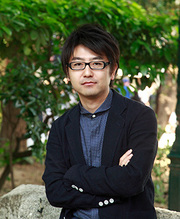 Koki Tanaka
Koki Tanaka
Born in 1975. In his diverse art practice spanning video, photography, site-specific installation, and interventional projects, Koki Tanaka visualizes and reveals the multiple contexts latent in the most simple of everyday acts. In his recent projects he documents the behavior unconsciously exhibited by people confronting unusual situations, e.g. a haircut given by nine hair stylists or a piano played by five pianists simultaneously, in an attempt to show an alternative side to things that we usually overlook in everyday living. Currently he lives and works in Los Angeles.
He has shown widely in and outside Japan: the Hammer Museum (Los Angeles), the Mori Art Museum (Tokyo), the Palais de Tokyo (Paris), the Taipei Biennial 2006 (Taipei), the Gwangju Biennial 2008 (Gwangju), the Asia Society (New York), the Yokohama Triennale 2011 (Yokohama), the Witte de With (Rotterdam), the Yerba Buena Center for the Arts (San Francisco), "Made in L.A." (Hammer Museum, Los Angeles), and the 2013 California-Pacific Triennial (Orange County Museum of Art).
Artist website: http://www.kktnk.com/
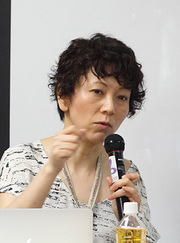 Mika Kuraya
Mika Kuraya
Chief Curator of the Department of Fine Arts, The National Museum of Modern Art, Tokyo, Mika Kuraya earned her MA at Chiba University. Her recent curatorial projects include: "Waiting for Video: Works from the 1960s to Today" (2009, The National Museum of Modern Art, Tokyo; co-curated with Kenjin Miwa), "Lying, Standing and Leaning" (2009, MOMAT), "Meaningful Stain" (2010, MOMAT), "On the Road" (2011, MOMAT), "Undressing Paintings: Japanese Nudes 1880-1945" (2011-2012, MOMAT). Recent critical studies include: "Where is Reiko? Kishida Ryusei's 1914-1918 Portraits" (Bulletin of the National Museum of Modern Art, Tokyo, No. 14, 2010).
Keywords
- Photo
- Handicraft
- Architecture
- Literature
- Film
- Arts/Contemporary Arts
- History
- International Exhibition
- Japan
- Italy
- Netherlands
- Germany
- Angola
- Venice Biennale
- Hikaru Fujii
- Venice
- Great East Japan Earthquake
- Ken Sasaki
- Nuclear power generation
- Kunio Yanagita
- The Legends of Tono
- Meiji Sanriku Earthquake
- Massimiliano Gioni
- Outsider art
- Bill Viola
- Kassel
- Documenta
- World War II
- Capitalism
- Atsushi Sasaki
- Keijiro Suga
Back Issues
- 2023.12. 7 Movie Theaters aroun…
- 2023.6.16 The 49th Japan Found…
- 2023.4.24 The 49th Japan Found…
- 2022.12.27 Living Together with…
- 2022.12.27 Living Together with…
- 2022.8.12 Inner Diversity <…
- 2022.3.31 The 48th Japan Found…
- 2022.3.29 Beyond Disasters - T…
- 2021.11.29 Crossing Borders, En…
- 2021.4.13 Crossing Borders, En…


